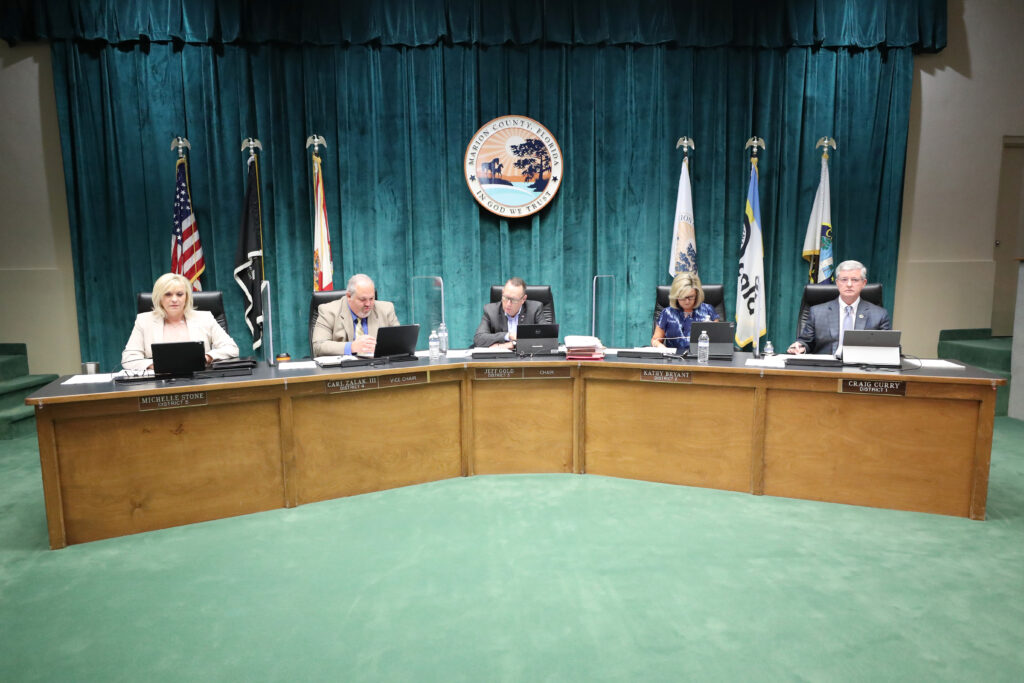Marion County fails leadership test

The Marion County Commission is shown during meeting in Ocala, Fla. on Tuesday, March 16, 2021. [Bruce Ackerman/Ocala Gazette] 2021.
Editor’s Note: Marion County allocated $7 million in grants to keep small businesses going. A previous version stated otherwise
Marion County’s efforts to distribute nearly $64 million in Coronavirus Relief Funds (CRF) meant to help our community during the early stages of the pandemic quickly devolved into an exercise of ineptitude at best and self-dealing at worst.

[Bruce Ackerman/Ocala Gazette]
Soon after the pandemic hit, $150 billion in federal Coronavirus Relief Funds, a substantial part of the $2.2 trillion CARES Act, was set aside for direct state assistance. The states, in turn, sent a portion of the money to local governments which, it was presumed, would know where it was most needed.
There were only a few strings attached, not typical of government largesse. The money was broadly meant to quickly help defray the cost of COVID-19, with the underlying goal of getting money flowing into a crippled economy. But small cities with a population of less than 500,000 would have to rely on their county to trickle the money down to them.
Marion County administration failed in that respect, reimbursing Ocala, Belleview and Dunnellon less than $1 million for its COVID-19 expenses.
Not only did Marion County fail in its moral obligation to equitably share the money with cities early on, its continued reluctance to share is unconscionable.
Its decision in December to sweep the lion’s share of the funds, approximately $34 million, into county coffers while continuing to cut out city governments smacks of greed and goes against the spirit of the CRF’s goals.
The county did quickly move to reimburse the area’s only non-profit hospital for $11.8 million in pandemic expenses.
But while allocating $7 million in grants to keep small businesses going and $4.2 million to aid non-profits, the process became fraught with red tape as multiple review boards took months to approve applications for aid. Some nonprofits were told it was too late to receive assistance because the program expired on Dec. 30. Even when the use-it or lose-it deadline was extended by the federal government, the county did not extend that deadline to non-profits.
No doubt, balancing the effort to get money out under a tight deadline while still maintaining proper oversight is daunting. Unfortunately, the county fell back to its usual bureaucracy when speed was not only needed but expected by the federal government.
Meanwhile, the county has spent $5.8 on renovations to many of its buildings, including the installation of touchless toilets, sinks and new flooring. Another more than $3 million went to computer and audiovisual equipment and hundreds of thousands were spent on new vehicles.
Setting aside the argument of whether the expenses were necessary, were the cities not entitled to the same upgrades?
The cities were not given the option to re-floor or install touchless faucets throughout their facilities. They were not given the option to seek reimbursement for the technology that allowed employees to work from home or keep public meetings open to the public.
No, the cities were limited to submitting receipts for personal protective equipment, COVID-19 testing, sick pay for city employees who got the dreadful virus and vaccine costs.
When the board of Marion County Commissioners outlined a plan to spend the money in July, they gave county administrators the authority to spend it without having to seek approval from the board as is usually the case. While that was a reasonable move to speed up the process of sending out aid in a crisis, the county administration has not been transparent with the public on the details of how the money was spent.
It was not until October that the first report outlining expenditures was provided to commissioners at a public meeting. The report was largely limited to the name of the vendor and a dollar amount. Specifics about the nature of the work done or details of what was purchased have never been publicly released.
It took the Ocala Gazette months and hundreds of dollars in public records fees to view a portion of the detailed expenditure reports.
In our opinion, the county must make a detailed report on expenditures available for public inspection.
Now that the height of the emergency is over, and the county is sitting on a balance of approximately $20 million, there is no reason the commission should not retake its role of reviewing and approving large expenditures in full view at public meetings.
The county must return to the normal rules of transparency and accountability, not only for the remaining funds but for the upwards of $70 million the county is expected to receive under the latest federal recovery funds.





